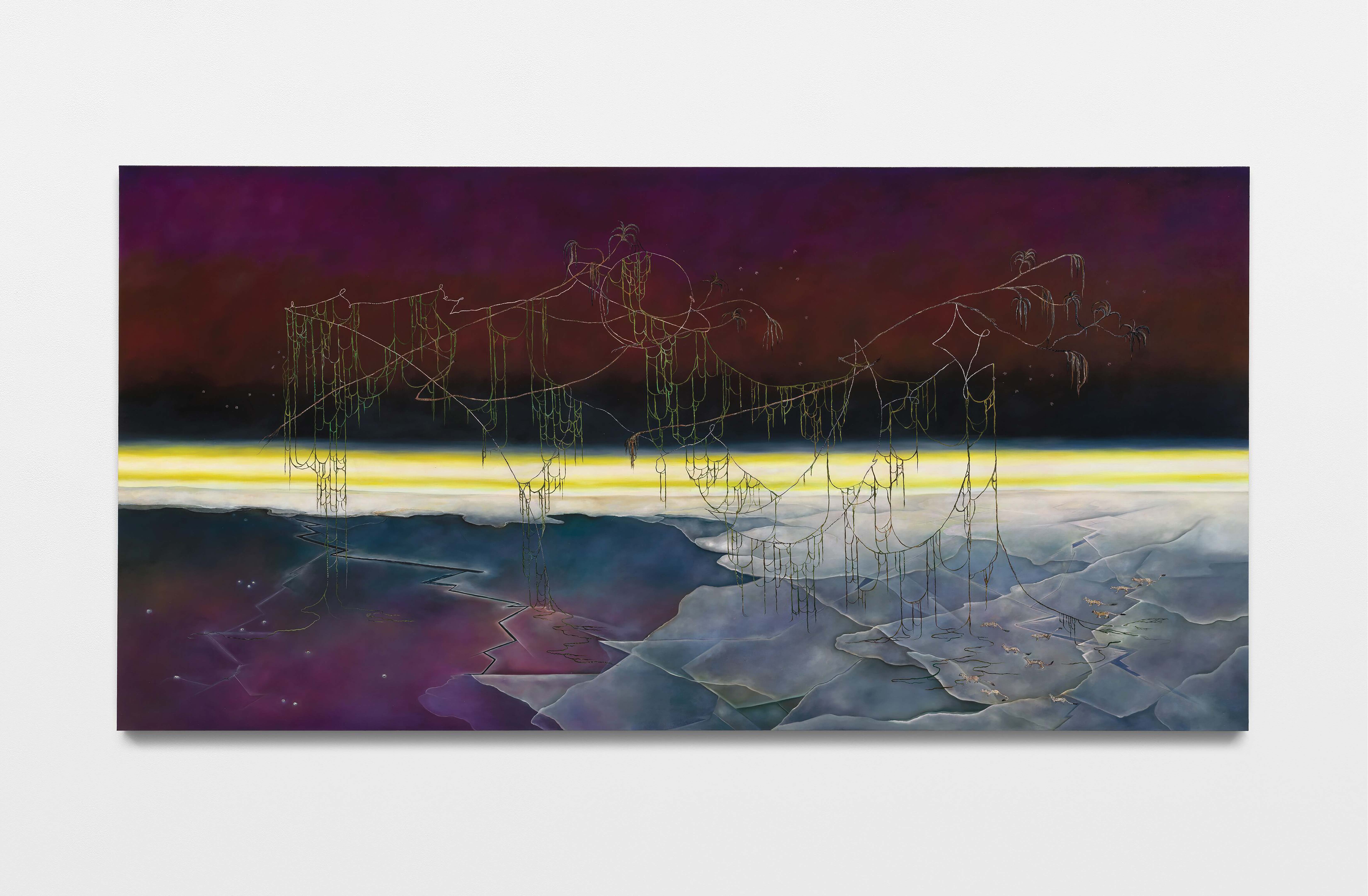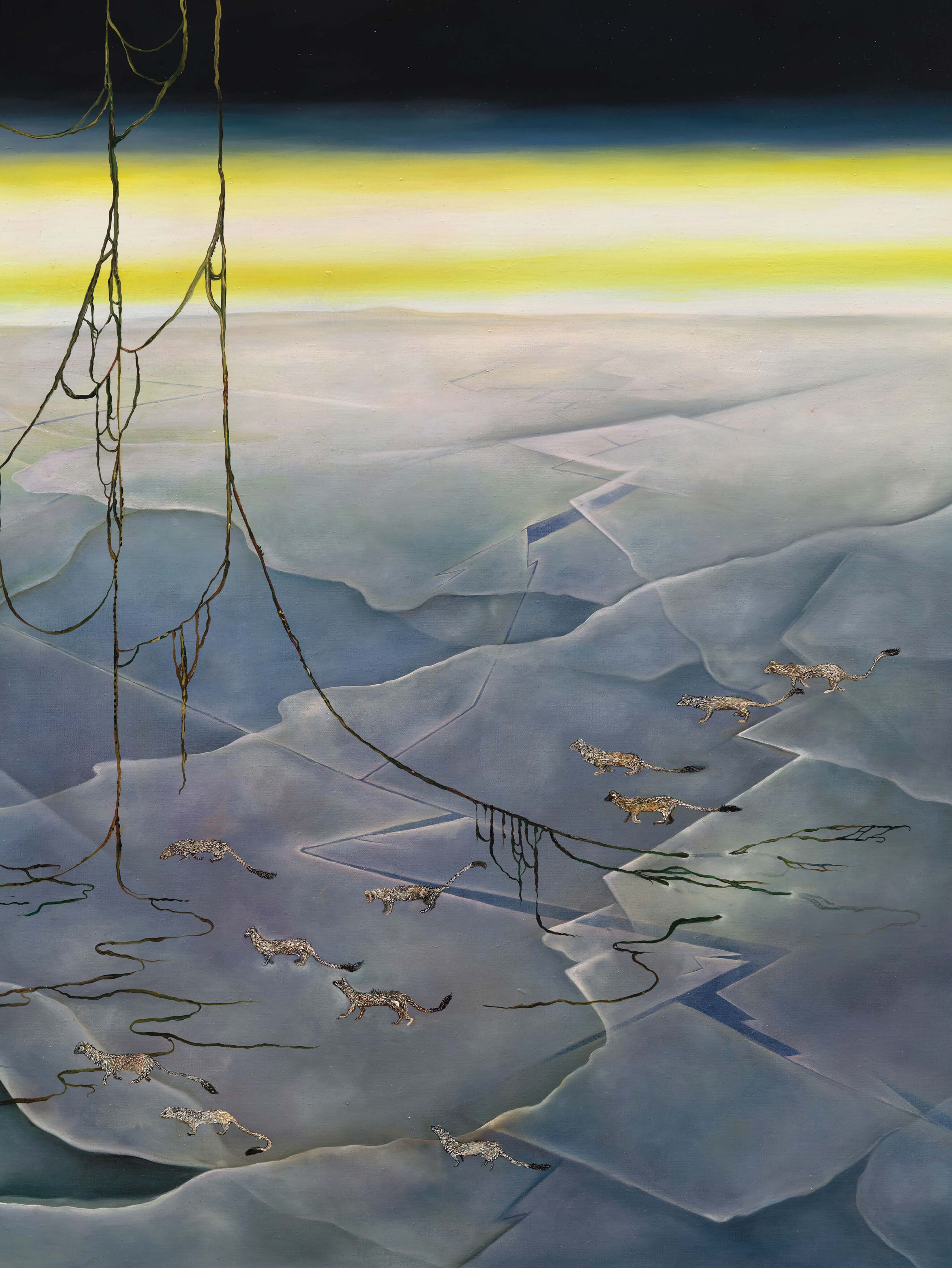F L A U N T


Halfway through my conversation with British painter Anj Smith, I realize a churlish desire to return to my adolescence. Back then, I sported long, mangled hair and a scowl, both physical side effects of a newly-developed punk feminist manifesto that drew me towards questionable slam poetry and unquestionably great music. I would like to show that version of myself Smith’s richly layered oil paintings, ones that explore rebellion against gendered bodies, ecological anxiety, and silenced mental health struggles through portraiture and landscape work. I tell Smith, who is preparing for The Sequin-Strewn Night—her first solo exhibition in Los Angeles in two decades set to open at the Hauser & Wirth in West Hollywood—as such, and she smiles at the familiar confession.

Anj Smith grew up in a strict household in Kent, England, where sleepovers at friends’ houses allowed for clandestine moments to watch otherwise banned media: L.A. Confidential. Pretty Woman. Hollywood, to Smith, was a land rich with artistic mystique, a perfect miasma: a place where story begot glamour; glamour begot excess; excess begot camp begot transgression. Decades later, having exhibited across the world and gained international repute for her tightly wound, intricate examinations of the body and the mind, Smith finds herself returning to the same processes that felt so magnetic in those moments of secretive viewership: Smith is interested in rejections and processes, the winding paths between intention and destruction.
“Laüstic,” the eighth poem in Marie de France’s 12th-century Lais collection, serves as a central reference for The Sequin-Strewn Night. Penned by one of the earliest known French female poets, the poem details lovers who communicate via nightingale song until the woman’s husband, enraged by the affair, kills the nightingale. The bird is wrapped in fabrics and exchanged as a lover’s token between the separated pair, the nightingale experiencing symbolic rebirth. “That is exactly what I’m trying to do in the studio with painting,” Smith says. “I’m trying to use these increasingly problematic legacies of Euro-Western painting tradition, which I don’t feel I can ignore as a painter,no matter how much I might like to, and turn them inside out and use them in a very subversive way.”

A drive to overturn conventional narrative is clear in Smith’s painting “The Martian,” which debuted at Art Basel Paris in 2024. In it, a semi-nude figure stands upright, gazing defiantly outward. Aqueous layers cover the naked flesh, ripples of fabric obstructing decaying leaves, exposed nipples, and a meticulously-crafted impasto lizard scrawled across the collarbone. Small details, like chipped nail polish and pierced ears, draw the observer in: the figure’s defiance simultaneously repels, and dares one to inch closer. Smith’s entire career has been about flipping these traditional symbols, blurring the lines of classical technique and outsider impulses.
“There’s a refusal to behave [in] the work,” Smith says of her oeuvre. “I think it’s really interesting to make paintings that use the language of quiet subversion and hopefully intelligence and criticality and subtle movement and nuance and layers.” For Smith, this can mean rejecting centuries-old tropes as well as seducing contemporary audiences with short attention spans.
Smith’s dedication to detail can, to a degree, be contextualized by her adolescence spent amidst the Young British Artists movement, during which artists like Damien Hirst and Tracey Emin were shepherded to art world supremacy through the sponsorship of advertising titan Charles Saatchi. Along with the rising relationship between minimalism and “high taste,” the art world felt foreign to Smith. “I like the idea of making a work that refuses to settle in any one direction,” she says of the contrasts between her process and the reception. “To hell with the conventional snobbery of it all. You need to be responsible as an artist for choosing appropriate language for what you’re trying to encapsulate.” An example of this refusal to comply is “Taste,” her 2017 painting of a blonde figure’s back. The horizon is low; dark green plants cut across the foreground. The figure’s hair is tied up in tendrils, woven with unknown substances and the scalp exposed from an undercut. Questions of concealment, revelation, and environmental anxiety linger unanswered, never wrapped up easily for consumption. Smith provides no relief from the worries.

Rather, Smith’s work asks others who also hold fears to navigate the world with them, rather than in spite of them. She regularly invites visitors to her studio, where gazing at her works in progress often evokes tears of recognition in her visitors—“people who have had to live their life obliquely,” she says. Smith, who navigates her own anxiety and postpartum depression, finds inspiration in artists like Emma Hauck, a German artist known for her handwritten letters created while institutionalized at a mental hospital. This sort of alienation is inseparable from the body Smith inhabits. She admits a past reticence in painting the female body, in relation to the canon’s complex and often damaged relationship to gendered sexuality. “I’m not sure if I’m painting my own desire, or if I’m painting my own masculinity, or whether I am refuting an idealism,” Smith wrote in a text to a friend one day, trying to understand how to shoulder a topic so near and complex. That language was revelatory. “I realized that I am painting the rat’s nest. I’m painting all of these different projections, refutations and idealizations, and all of that still affects our day-to-day reality.”
With the invitation of others into her studio, Smith considers performance–the honesty of the relationship between the producer and the consumer, the real nature of showing off. Her latest series, Performer, features three paintings of harlequin figures, which she considers a love letter to LA and “to people who create space to wrench aside the everyday perception of things and offer another vision.” The harlequins are dressed in printed, shimmery tights, pubic hair visible through neon lighting. The jokers dress to tease the audience and direct attention, powerbrokers of the stage.

Anj Smith’s work meanders through an uncertain inner terrain, stopping to ponder the small ways desire can erode a physical being, or transform it beyond recognizability. Smith’s work flourishes in the gaps between the observed world and its mutations across media.
We end our conversation conversing about duality—or rather, with a discussion of the burrowing owl, a ferocious predator and the soundtrack to many of my younger summer evenings. I recall being small, allowing the sounds of those owls that returned, night after night, in trees outside my bedroom window, to lull me to sleep, myself blissfully unaware of the small creatures picked up by their fearsome talons. Smith finds a sort of kinship with the animal—both a predator and a soothsayer. She returns to Los Angeles with The Sequin-Strewn Night following a year of local distress and remarkable civic resilience for the city, reminding herself of the power of art for both its capacity to heal and to act as an agent of demonstrable social change. “Painting is always a testament to human resilience and ingenuity,” she says. Look out for the burrowing owl, whose calming coos embody Anj Smith’s loudest rebel yell yet.
